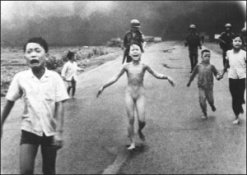bjorke
Member
Hijacking cate's comment from (there was a url link here which no longer exists)
I am certainly a result of cultural encoding, in that I immediately saw the falling man as a horrifying parody of images like this Masaccio that I'd grown up seeing every single day:


For some reason editors are fond of cropping-away the building, and also of setting the falling man off-center. But for myself, I have never been able to shake the comparison, made stronger but the vertical rays and left-right split tones of the original -- the falling man helpless between dark and light.
--
I mention this because I feel that it scrapes at the surface of What Makes Photographs Important. Questions of divinity aside, people today still remember the Roman occupation of Palestine because of the story of ONE MAN whom they feel affinity to, out of the many thousands who were apparently treated just as badly by the occupation forces. This hints to me at truths about fundamental mechanisms of human morality and how they influence our responses to all pictures. YMMV of course.
The photograph of the 'falling man' is different from anything I've ever seen before. It is beyond the photographs I have seen of war, famine, disease, brutality, disaster. By 'beyond' I don't mean in the sense of being worse, but different. Too complex, too terrible and multi layered to talk about here.
I am certainly a result of cultural encoding, in that I immediately saw the falling man as a horrifying parody of images like this Masaccio that I'd grown up seeing every single day:


For some reason editors are fond of cropping-away the building, and also of setting the falling man off-center. But for myself, I have never been able to shake the comparison, made stronger but the vertical rays and left-right split tones of the original -- the falling man helpless between dark and light.
--
I mention this because I feel that it scrapes at the surface of What Makes Photographs Important. Questions of divinity aside, people today still remember the Roman occupation of Palestine because of the story of ONE MAN whom they feel affinity to, out of the many thousands who were apparently treated just as badly by the occupation forces. This hints to me at truths about fundamental mechanisms of human morality and how they influence our responses to all pictures. YMMV of course.






